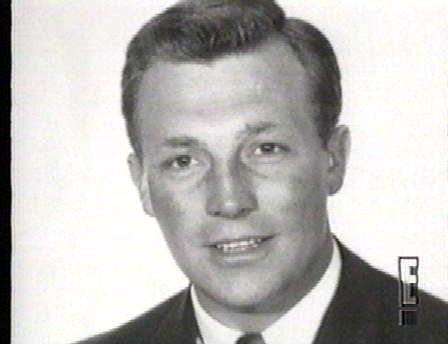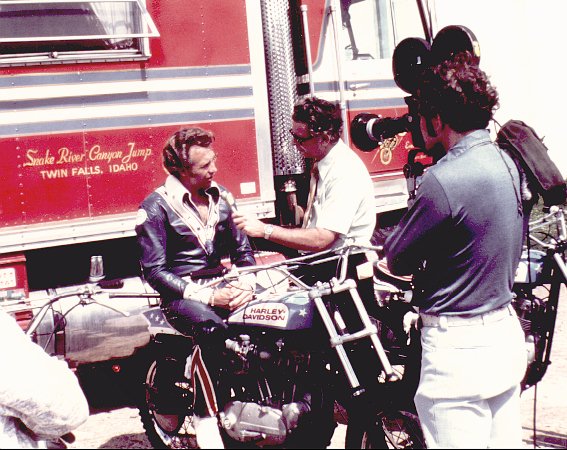





EVEL KNIEVEL

Biography
Born in the wide open copper mining town of Butte, Montana October 17, 1938, Robert Craig Knievel was raised by his grandparents. At age eight he saw Joey Chitwood's Auto Daredevil show which he credits for his later career choice to become a motorcycle daredevil.
Outstanding in track and field, ski jumping and ice hockey at Butte High School he went on to win the Northern Rocky Mountain Ski Association Class A Men's ski jumping championship in 1957 and to play with the Charlotte Clippers of the Eastern Hockey League in 1959. He then formed the Butte Bombers semiprofessional hockey team, acting as owner, manager, coach and player.

He worked in the copper mines as a contract miner, skip tender and diamond drill operator. After a stint in the US Army where he pole vaulted and ran the 220 on the Army track team, he ran his own hunting guide service in Montana. During that time he learned that excess elk were being slaughtered in Yellowstone Park and decided to launch a campaign to save them and relocate them to areas open to hunters. In 1961 , at age 23, he hitch-hiked to Washington, D.C. with a pair of elk antlers and presented his case to a John F. Kennedy Presidential Aide, Congressman Arnold Olsen, Senator Mike Mansfield and Interior Secretary Stewart Udall. As a result the slaughter was stopped and the animals have since been regularly captured and transported by the US government to areas in Montana, Wyoming and Idaho.

In 1962 Knieval broke his collarbone and shoulder in a motorcycle race. While on the mend he took a job as a salesman for the combined Insurance Company of America, selling in one week a record total of 271 policies. He credits much of his personal success to company president W. Clement Stone's philosophy of maintaining a positive mental attitude. He later opened several Honda dealerships in Washington state, drumming up business by offering $100 off of the price of a motorcycle to anyone who could beat him at arm wrestling. In 1965 he began his daredevil career when he formed a troupe called Evel Knivel's Motorcycle Daredevils, a touring show in which he performed stunts as riding through fire walls, jumping over live rattlesnakes and mountain lions and being towed at 200 miles an hour behind dragster race cars holding on to a parachute. In 1966 he began touring alone, barnstorming the Western states. Evel did everything himself, including truck driving, ramp erecting, promoting and performing his ever longer and more dangerous motorcycle jumps. In the begining he charged $500 for a jump over two cars parked between ramps. He steadily increased the length of the jumps and then on New Year's Day 1968, he jumped 151 feet across the fountains in front of Caesar's Palace in Las Vegas.

Successfully clearing the fountains, his landing was a disaster, and his injuries put him in the hospital in a coma for 30 days. While recovering, he decided to make it his goal to jump the Grand Canyon. In the next few years the payment for his performances increased to $1 Million for his jump over 13 buses at Wembley Stadium in London and over $6 Million for the Snake River Canyon jump.

International media attention to Evel's heroic, death-defying feats and his popular messages to the world's youth, promoting abstention from drugs and a healthy lifestyle witha positive mental attitude quickly transformed him into a National Icon. He bacame America's Legendary Daredevil. Though having attained super-star status, and genuine friendships with other stars like Elvis Presley, Jackie Gleason and Muhammed Ali, he remained affable and accessible to ordinary working people and children.
In the winter of 1976 Evel was seriously injured during a nationally televised performance of an attempt to motorcycle jump a tank full of live sharks in the Chicago Ampitheater. For the first time a bystander was also injured whena cameraman was struck, eventually losing an eye. Knievel, who suffered a brain concussion and two broken arms, decided to retire from major performances but continued to do smaller exhibitions around the country with his son Robbie, establishing him as his successor.

Evel still holds the all time ABC's Wide world of sports TV viewing audience record for his 52% of household share when his King Island performance was broadcast in 1975. Two major motion pictures by Warner Bros. have featured Knievel, "Evel Knievel" starring George Hamilton as Evel in his life story and "Viva Knievel", a thriller starring Evel as himself. Viacom productions did a made for TV movie starring Sam Elliot as Evel, plus Evel again starred as himself with Lindsey Wagner in an episode of the popular 1980's TV series "Bionic Woman". In the late 1970's and early 1980's the Evel Knievel Toys produced by Ideal Toy Co. and other products such as pinball machines, bicycles, watches, radios and other accessory items sold over $300 million dollars in entertainment to America's children. Knievel was credited with re-vitalizing the poorly performing toy industry in the 70's.
In a career as an artist in the 1980's he painted mostly western and wildlife scenes and sold thousands of limited edition prints in art galleries nationwide. His Motorcycle and Memorabilla display by the Smithsonian Institute in their Museum of American History in Washington, D.C. has immortalized him as America's Legendary Daredevil. In September, 1974 he was featured on the cover of Sports Illustrated Magazine. He is listed in Who's Who and the Guiness Book of World Records as having broken 35 bones. There is a river in Arkansas named after him.

Evel has been an avid golfer most of his ilfe and continues to play regulary. He enjoys all sports and likes to watchand wager on football, basketball and hockey games. He has been a generous contributor to charities and currently is promoting the work of the "Make a Wish Foundation", an organization that arranges the fulfilment of the dreams of children suffering from terminal illnesses.
Photos
Films and Television